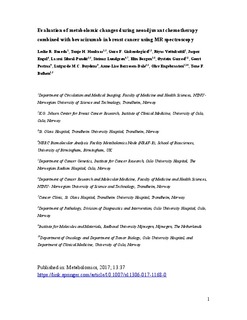| dc.contributor.author | Euceda, Leslie R. | |
| dc.contributor.author | Haukaas, Tonje Husby | |
| dc.contributor.author | Giskeødegård, Guro F. | |
| dc.contributor.author | Vettukattil, Muhammad Riyas | |
| dc.contributor.author | Engel, Jasper | |
| dc.contributor.author | Silwal-Pandit, Laxmi | |
| dc.contributor.author | Lundgren, Steinar | |
| dc.contributor.author | Borgen, Elin | |
| dc.contributor.author | Garred, Øystein | |
| dc.contributor.author | Postma, Geert | |
| dc.contributor.author | Buydens, Lutgarde M.C. | |
| dc.contributor.author | Børresen-Dale, Anne-Lise | |
| dc.contributor.author | Engebråten, Olav | |
| dc.contributor.author | Bathen, Tone Frost | |
| dc.date.accessioned | 2017-05-31T07:50:40Z | |
| dc.date.available | 2017-05-31T07:50:40Z | |
| dc.date.created | 2017-04-19T16:48:18Z | |
| dc.date.issued | 2017 | |
| dc.identifier.issn | 1573-3882 | |
| dc.identifier.uri | http://hdl.handle.net/11250/2443932 | |
| dc.description.abstract | Introduction
Metabolomics investigates biochemical processes directly, potentially complementing transcriptomics and proteomics in providing insight into treatment outcome.
Objectives
This study aimed to use magnetic resonance (MR) spectroscopy on breast tumor tissue to explore the effect of neoadjuvant therapy on metabolic profiles, determine metabolic effects of the antiangiogenic drug bevacizumab, and investigate metabolic differences between responders and non-responders.
Methods
Breast tumors from 122 patients were profiled using high resolution magic angle spinning MR spectroscopy. All patients received neoadjuvant chemotherapy, and were randomized to receive bevacizumab or not. Tumors were biopsied prior, during, and after treatment.
Results
Principal component analysis showed clear metabolic changes indicating a decline in glucose consumption and a transition to normal breast adipose tissue as an effect of chemotherapy. Partial least squares-discriminant analysis revealed metabolic differences between pathological minimal residual disease patients and pathological non-responders after treatment (accuracy of 77%, p < 0.001), but not before or during treatment. Lower glucose and higher lactate was observed in patients exhibiting a good response (≥90% tumor reduction) compared to those with no response (≤10% tumor reduction) before treatment, while the opposite was observed after treatment. Bevacizumab-receiving and chemotherapy-only patients could not be discriminated at any time point. Linear mixed-effects models revealed a significant interaction between time and bevacizumab for glutathione, indicating higher levels of this antioxidant in chemotherapy-only patients than in bevacizumab receivers after treatment.
Conclusion
MR spectroscopy showed potential in detecting metabolic response to treatment and complementing other molecular assays for the elucidation of underlying mechanisms affecting pathological response. | nb_NO |
| dc.language.iso | eng | nb_NO |
| dc.publisher | Springer Verlag | nb_NO |
| dc.relation.uri | https://link.springer.com/article/10.1007/s11306-017-1168-0 | |
| dc.title | Evaluation of metabolomic changes during neoadjuvant chemotherapy combined with bevacizumab in breast cancer using MR spectroscopy | nb_NO |
| dc.type | Journal article | nb_NO |
| dc.type | Peer reviewed | nb_NO |
| dc.source.volume | 13 | nb_NO |
| dc.source.journal | Metabolomics | nb_NO |
| dc.source.issue | 37 | nb_NO |
| dc.identifier.doi | 10.1007/s11306-017-1168-0 | |
| dc.identifier.cristin | 1465577 | |
| dc.description.localcode | This is the authors' accepted and refereed manuscript to the article. Locked until 17 February 2018 due to copyright restrictions, The final publication is available at Springer via http://dx.doi.org/10.1007%2Fs11306-017-1168-0 | nb_NO |
| cristin.unitcode | 194,65,25,0 | |
| cristin.unitcode | 194,65,15,0 | |
| cristin.unitname | Institutt for sirkulasjon og bildediagnostikk | |
| cristin.unitname | Institutt for kreftforskning og molekylær medisin | |
| cristin.ispublished | true | |
| cristin.fulltext | postprint | |
| cristin.qualitycode | 1 | |
